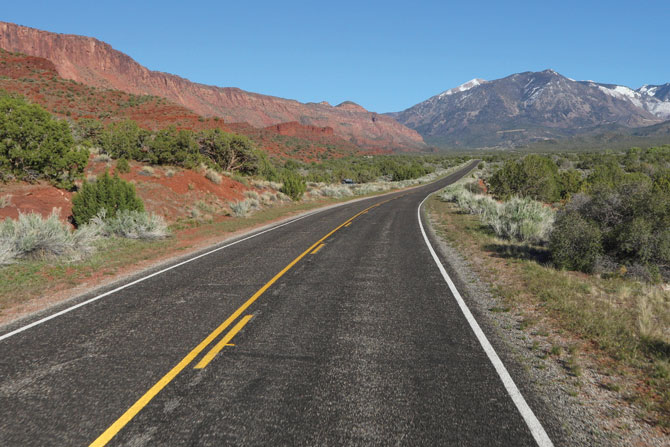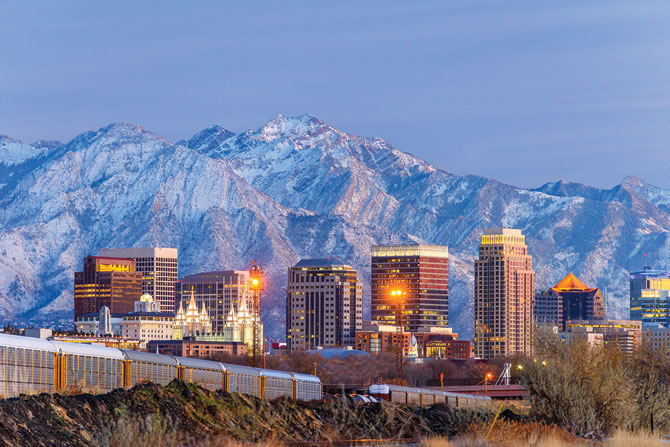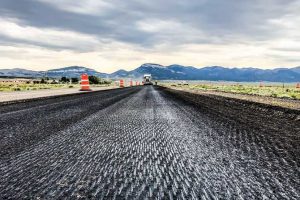The Utah Section of the American Society of Civil Engineers (ASCE) recently published the 2020 Report Card for Utah’s Infrastructure. Craig Friant, P.E., was the Report Card Chair, and Ryan Maw, P.E., D. GE, was the Vice-Chair. Experts in each chapter’s subject wrote individual chapters. For a complete list of authors and contributors, please refer to the report itself.
While the report was being written:
- The COVID-19 pandemic changed the world. Utah was not exempt; infrastructure use and funding were both affected because people stayed home as much as possible, and user-generated revenue streams declined significantly.
- A moderate earthquake event in Magna on March 18, 2020, reminded everyone that Utah is in the Intermountain Seismic Belt. Residents were displaced, structural damages totaled more than $62 million, public infrastructure damage totaled $70 million, and economic losses were $629 million. Utah was lucky. If the earthquake had affected the east valley benches instead, it would probably have been 60 times stronger and damages would have been in the billions. The earthquake was a reminder that unreinforced masonry buildings, including schools, are both at risk.
- In 2021 President Biden began a much-needed effort to improve the country’s infrastructure.
Each infrastructure category received a letter grade, as follows:
- A: Exceptional, fit for the future
- B: Good, adequate for now
- C: Mediocre, requires attention
- D: Poor, at risk
- E: Failing/Critical, unfit for purpose
Utah’s overall grade was a C+. Categories and grades included:
- Aviation: C
- Bridges: B+
- Canals: D
- Dams: C+
- Drinking water: B-
- Hazardous Waste: C+
- Levees: D-
- Roads: B+
- Solid Waste: B-
- Stormwater: C+
- Transit: B+
- Wastewater: C
Although Utah’s C+ grade is disappointing, you have to put it in context: no one else did better, and only one state (Georgia) did as well. The grade is like the Magna earthquake. We need to do better, but the grade we received could have been worse than it was.
Aviation: C
Utah has an aviation infrastructure that includes 36 public use airports for general and commercial aviation, but 98% of the state’s passengers get on a plane at the Salt Lake City International Airport. Five airports offer commercial air service, and two airports offer commercial air service but are non-primary airports. Daily air traffic is less than 10 planes per day at most airports.
Aviation makes money. It supports businesses and tourists. Since the airports were originally built, however, security needs and earthquake safety standards have both changed.
The Salt Lake City International Airport is undergoing the Airport Redevelopment Program; the $4 billion program began in July 2014 and is scheduled for completion in 2024. St. George Municipal Airport just finished removing and reconstructing the main runway. The runway is now back in service. Provo has upgraded terminal facilities, but the Provo Municipal Master plan needs updating. Ogden Hinckley Municipal Airport is developing a master plan. Ogden released a final draft in March 2020. Old, outdated hangers need to be removed and replaced, but the runway pavement is in good condition, and the taxiways and aprons are in good to poor conditions.
Most money for airport improvements comes from the federal government. To raise the grade, Utah needs to:
- maintain or improve service levels
- monitor performance metrics as a guide to future planning
- find a way to give regional airports the funding they need
- find new revenue streams to modernize airports and increase their capacity
- reduce runway incidents through training

Bridges: B+
Utah has more than 3,000 highway bridges. They are a critical part of Utah’s surface transportation systems. In 2016, funding for bridges was $26.5 million; in 2018-2020, it was $48 million annually. The money has made a big difference, but Utah’s bridges generally have a 50-year design life, and one out of three is older than that. Replacing them will cost about $1.9 billion, and repair costs will be about $1.3 billion. In the next 10 years, another 450 bridges will be 50 years old. The replacement cost will be about $900 million, and the repair cost will be about $600 million.
A growing population will need 30-40 new bridges per year to meet Utah’s expected growth of 20% over the next 10 years.
Money for bridges comes from federal, state and local sources.
To raise the grade, Utah needs to:
- continue putting money into its bridges and supporting innovative solutions to transportation challenges
- balance the need for repairs and replacement with new construction
When it comes to this kind of innovation, Utah is on the leading edge. We need to stay there.
Canals: D
Utah has 5,300-8,000 miles of canals, mostly consisting of earthen embankments and cut ditches. In their day, more than 100 years ago, they were engineering marvels that protected fields from flooding and helped Utah grow and prosper.
Today, flooding is less likely to affect fields and more likely to affect cities, public infrastructure, and developments. Regulation is very limited, even though cities have grown and the need for water rights management has increased. There are more than 1,140 canal companies and 200 private owners who currently self-regulate the entire system. Funds and resources have decreased as the canals have transitioned away from agricultural uses. What used to work for getting water to farms now has to work as part of flood management, which is much more complicated than the canals were originally intended. Liability has also increased.
Raising the grade for canals is important, Utah needs to:
- fund, prioritize and establish support and oversight for Utah’s canal systems
- create a long-term plan for the future that involves project stakeholders
- put together multidisciplinary teams to assess risks and figure out solutions – plans should analyze the impact of urban growth and climate change
- address and clarify the legal issues associated with jurisdictional authority
- assess and engineer canal hazards that impact infrastructure to modern standards
Dams: C+
There are more than 900 dams in the State of Utah. Of these dams, 860 are on the National Inventory of Dams (NID) and 266 are considered high hazard. The State of Utah manages 212 of these high hazard dams while 54 of them are under federal jurisdiction. Utah faces a number of unique dam safety challenges regarding the dam’s ages, seismic risks near major population centers, and a continuing trend of urban growth near breach zones.
As dams approach the end of their design lives, the downstream demand and development increases, current low risk dams are gradually becoming high risk dams through urban encroachment.
Utah provides approximately $3.8 million of funding per year for routine dam rehabilitation projects. The rehabilitation program has been in effect for over 20 years and 45 dams have been rehabilitated to meet current safety standards. As the infrastructure ages, more funding will be needed to keep these dams operational due to sediment accumulation, wear and tear on outlet systems, and upgrades to meet seismic and construction standards.
Raising the grade on dams is vital. Utah needs to:
- evaluate of the condition of all high hazard dams within the state
- expedite rehabilitation for dams within the state
- increase funding to maintain and upgrade the state’s dams
- make plans to achieve satisfactory ratings within the next 25 years and secure funding to keep the rating
Drinking Water: B-
Most of Utah’s growing population is served by drinking water networks that operate under multiple threats. A growing population, significant funding needs, and seismic concerns are just a few of the issues the state is facing. Because water supply is such a critical issue in Utah, adequate planning and associated infrastructure maintenance is vital.
Utah is one of the most arid states in the nation and water supply is a major issue. Building and maintaining the infrastructure to move water supplies is a critical part of Utah’s water conservancy districts’ missions. Success is critical, as about 90% of Utah’s urban population lives in the northern part of the state, away from the water supply sources.
To raise the grade on drinking water, Utah needs to:
- invest in systems that provide for future water supply needs
- appropriate specific funding to consider long-range alternatives, such as out-of-state sources from areas that might be less negatively impacted by climate change
- support and fund not only contingency planning and preparation activities, but also consider the construction of certain measures that could minimize, or in fact, possibly eliminate, damage/displacement of major water supply conduits that are susceptible to a major seismic event
- promote and fund the extension of SAMPs programs for smaller water systems, including the provision of technical support
- fund and support an analytical analysis of future water system financial requirements, given the rapid growth of population and urban development
- further, the state should consider financially supporting water supply and distribution entities, such as is currently practiced with transportation, e.g., UDOT’s freeway construction
Hazardous Waste: C+
Hazardous wastes, such as byproducts of mining and manufacturing, present complex management and potential cleanup challenges to communities throughout Utah. Furthermore, electronic wastes containing lead and other heavy metals represent a growing concern when improperly disposed of in landfills. Ongoing cleanup concerns and no clear policy on banning e-waste from landfills is holding Utah back.
Nationally, Utah ranked 36th in hazardous waste generation, 20th in hazardous waste management, and 12th in quantity of imported hazardous wastes.
To raise the grade on hazardous waste, Utah needs to:
- enact legislation prohibiting the disposal of electronic wastes in landfills
- make a coordinated public commitment to achieving sustainable, circular electronics and manufacturing lifecycles which reduce waste, increase opportunities for manufacturers to recycle and reuse valuable materials, and eliminate toxic processes and byproducts whenever possible
- leverage Utah’s strong culture of public-private partnerships and entrepreneurship to grow “re-manufacturing” jobs within the State of Utah to achieve a sustainable, circular economy
- engage electronics manufacturers, retailers, and recycling service providers to develop a robust electronics takeback and recycling program available statewide
- require toxic material and chemical reduction or substitution in consumer products and industrial processes as soon as suitable alternatives can be identified
- maintain or expand funding for innovative brownfields redevelopment programs which prioritize serving low-income or otherwise historically disadvantaged communities
- continue to engage private partners in voluntary cleanup and monitoring of potentially contaminated property before resale, redevelopment, or transfer
- set policies that help to develop strong local recycling markets in Utah.

Levees: D-
Levees are instrumental to Utah’s flood control system. There are between 102 and 112 miles of levees statewide with approximately 252 individual segments averaging nearly 60 years old. It’s estimated that over 125,000 residents are protected by the state’s levee infrastructure and the total risk to property should failure occur exceeds $10 billion.
In much of the state, limited to no planning exists for emergencies such as levee breaches. Changes to federal flood mapping, which will increase insurance costs, may mean that many owners cannot afford coverage and would therefore not be eligible for federal recovery funding if flooding occurs. Absent available state and federal funding, local municipalities have taken action to address changes in flood mapping and levee deficiencies.
Raising the grade for levees is important, and the state has begun to recognize and address that need. Utah needs to:
- define, inventory and identify levees across the State of Utah into a single database. Given the forthcoming change in flood mapping, this legislative action should be completed within five years
- fully fund the National Levee Safety Program, which would provide more reliable levee systems and funding to provide an integrated approach to protect people and property from floods
- assign or further clarify jurisdictional authority or watershed committee at a state level to coordinate levee condition assessments, resources, funding, costs for mitigation, repair, development, and emergency action plans. Require that operation and maintenance plans cover all aspects of a complex regional and statewide levee system
- assess levees using updated hydrology and hydraulic analyses that incorporate the impact of urbanization and climate change
- increase funding at all levels of government and leverage private funds to address structural and nonstructural solutions that reduce risk to people and property from flooding hazards.
- consider alternative funding sources, and other risk reduction measures such as better outreach/education and warning and evacuation systems
Roads: B+
Utah has a comprehensive roadway network of approximately 49,290 miles (73% local, 2% Interstate, 25% State), 40% of which are in mediocre or poor condition. For Utah to remain a modern-day crossroads serving extensive freight traffic from regional ports, funding increased from $1.2 billion in 2017 to $1.7 billion in 2020 and major capacity investments continue. Utah also embraces innovation and asserts fiscal leadership through the 2020 institution of a Road Usage Charge (RUC) for electric and hybrid vehicle owners and the 2021 gas tax increase from $0.311 to $0.314 per gallon. Finally, in recent years the state has also streamlined Transportation Asset Management Plans (TAMP) and project risk analysis to preserve roadway infrastructure, increase its adaptability amid extreme events, and maintain its functionality after extreme events occur.
With the state’s population projected to increase more than 56 percent by 2050 according to the U.S. Census Bureau, there is a significant need for new roads and highways, as well as for mass transit and other methods of transportation.
Utah is one of the leading states in the country for using innovation to find solutions to the State’s transportation needs.
Recommendations for Utah to maintain and raise their grade on roads are:
- continue to use state funding for transportation projects from sustainable and appropriate funding sources
- increase the gas tax and continue to find alternative transportation revenue such as the Road Usage Charge program
- continue to improve life cycle costs assessments to determine a project’s true cost and use this information to select projects that provide the best value to the State and its residents
- continue to invest in research to identify technologies and innovative transportation systems to improve congestion and safety
- invest in infrastructure to facilitate the use of autonomous vehicles and vehicle to vehicle communications

Solid Waste: B-
Since 2013, the number of solid waste landfills in Utah has increased from 107 to 122 while only 5% of the state’s total usable landfill area has been used. While the system’s capacity is increasing, the current condition of the state’s solid waste sector is somewhat unknown as Utah’s Solid Waste Master Plan has not been updated in nearly 15 years.
Future needs Utah’s estimated population in 2023 is projected to be about 3.4 million, and it is projected to increase more than 40% by 2040. With the increasing population and no behavior change in recycling pattern, an increase in the total tonnage of solid waste is expected. From the forecast, there will be roughly 7.8 million tons of solid waste generated by 2023 asserting more capacity demands on the state’s existing landfills.
To address this issue and raise the solid waste grade, Utah needs to:
- educate Utah residents about solid waste recycling
- conduct regular DEQ landfill facility inspections
- update the Solid Waste Master Plan
Stormwater: C+
It is estimated that there are between 5,000 to 10,000 miles of storm drains in Utah. These systems range in age from the early 1900s to current development projects being completed each month across the state. Systems are being converted to storm drains as urbanization is increasingly requiring canal owners to evolve from water conveyance for farming to flood management conduits for municipalities. However, canals are not the best type of stormwater conveyance infrastructure due to the decreasing capacity as they move downstream.
With aging systems, it is important to perform maintenance and repair to ensure appropriate operation; however, not all of the state’s stormwater systems have and exercise asset management. Dependent on stormwater utility fees and limited state-level funding and financing resources, ongoing upkeep to avoid system failures and to comply with new stormwater standards may become more challenging. However, addressing the increasingly stringent standards will likely fall onto stormwater system owners as the state only has $1 million to contribute to innovative stormwater projects.
To raise the grade on stormwater, Utah needs to:
- provide long-term funding strategies for inspection and maintenance of storm drains across the state at the municipal level. This funding should also provide funding for asset management systems and period inspections
- create methods of funding long-term replacement of storm drain infrastructure above capital improvement programs
- update hydrology and hydraulic analyses to incorporate the impact of urbanization and climate change on existing systems during future master plan activities.
- provide consistent, repeating state level funding or additional loan opportunities for municipalities that function on resource limited budgets

Transit: B+
Over the past 30 years, transit networks in Utah have significantly improved. Currently, there are over 100 miles of fixed guideway services and over 48 million annual riders, up an additional two million in the last five years. While these transit improvements have made the system more convenient and user- friendly, there are still pressing needs for system enhancement, expansion, and financial stabilization. Sales taxes from local service districts support 65% of the transit system’s funding, with the remainder coming from federal sources.
Recent innovations, such as Bus Rapid Transit (BRT) systems, provide increased and consistent service without requiring extensive infrastructure additions. Bus Rapid Transit systems combine bus fleets with dedicated lanes to create a system similar to a light rail or a metro system without the large infrastructure cost.
One of the greatest challenges facing transit statewide is funding. Federal funding sources including federal preventative maintenance, federal grants, federal planning assistance, and preventative maintenance grants for capital expenses have been decreasing in recent years and show no sign of returning to previous levels. As of 2019, UTA’s annual budget was $456.8 million, with the sales taxes in the service district providing the largest funding portion of 65%. The rest of the funding is covered through federal funding, passenger fares, and advertising revenue.
To raise the transit grade, Utah needs to:
- locate additional funding sources to increase the regularity and improve the accessibility of service to both urban and rural users.
Wastewater: C
Wastewater infrastructure systems in Utah are meeting baseline technology limits, but new nutrient regulations and an increasing population are requiring older facilities to implement costly upgrades. Estimates project $15 billion in funding will be required over the next 40 years to meet water quality standards.
Issues impacting the public safety are emerging and have not been addressed due to lack of permanent and adequate funding mechanisms. Drought can cause groundwater levels to drop, allowing wastewater to leak out of sewers (exfiltrate), degrading groundwater quality. Also, there is a need to supplement drinking water supplies in arid climates and nontraditional sources of purified water, including wastewater recycling.
To address the wastewater issues, the state needs to:
- continue to implement condition and performance assessments
- expand asset management and maintenance management programs
- focus on extending the life cycle of infrastructure in keeping with the goals of the ASCE Grand Challenge
- communicate the value of wastewater infrastructure to our community, policymakers and legislators
- identify opportunities to improve efficiencies, including administrative and bureaucratic systems, management, engineering, construction, and operations and maintenance
- seek increased funding for infrastructure improvements to keep Utah’s water healthy
For more information and to read the entire report go here: https://infrastructurereportcard.org/state-item/utah/







